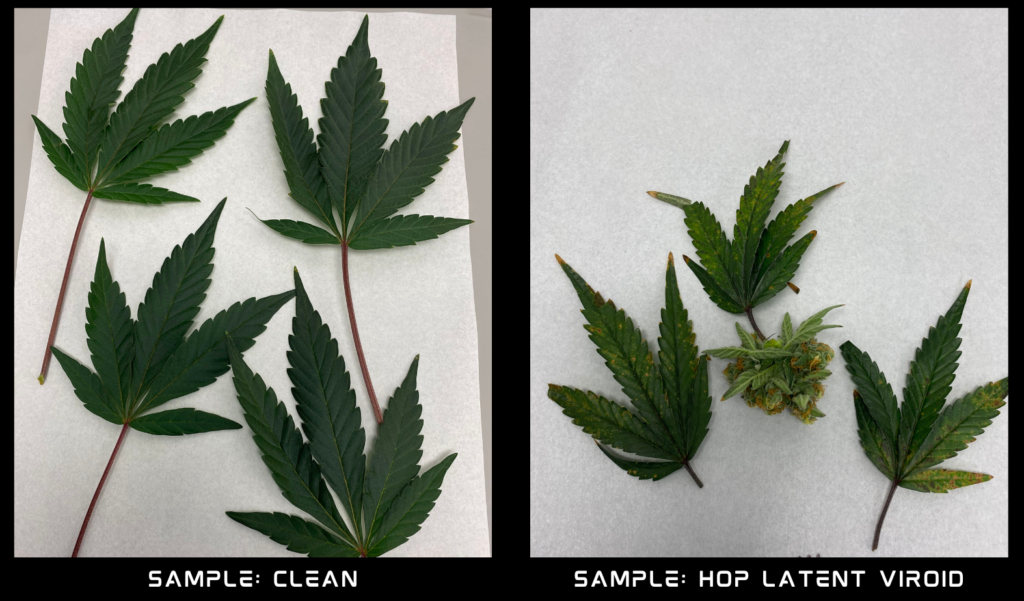What is Hop Latent Viroid (HLVd)?
Hop Latent Viroid (HLVd) is an infectious plant pathogen that causes disease in cannabis. HLVd is a viroid that contains a single-stranded RNA molecule that replicates using host plant enzymes to make new copies. Hop Latent Viroid can remain latent or inactive within infected plants, making it nearly impossible to detect without molecular testing. Although plants with HLVd can be asymptomatic, those that exhibit symptoms will normally have a lower cannabinoid yield. Cannabis is a highly regulated crop, and HLVd can cause significant economic losses for growers. With that said, it is becoming increasingly important for cannabis operators to perform Hop Latent Viroid testing early in the cultivation process to avoid potential pitfalls. Savvy cultivators are entrusting their samples for HLVd testing to reputable labs like Modern Canna. Test your cannabis products now for HLVd with Modern Canna, the cannabis industry’s most trusted certified marijuana testing laboratory.
What are the symptoms of Hop Latent Viroid in cannabis?
Cannabis plants with HLVd infection exhibit no visible symptoms at first, making the disease difficult to detect. Cannabis plants infected with HLVd may have half the cannabinoid content of their healthy counterparts. HLVd can affect cannabis plants’ quality by reducing THC levels, the psychoactive compound that gives cannabis its euphoric effects. In its latent state, HLVd spreads quietly until triggered by secondary stress such as heat, nutrition, or pests. Without testing, the first outbreak is difficult to detect.
Plants may develop the following symptoms:
- Stunted growth: Cannabis plants with HLVd infections commonly exhibit stunted growth. Viruses can impair the plant’s ability to absorb nutrients, leading to slower growth and smaller plants.
- Leaf abnormalities: HLVd can cause misshapen or curled leaves on infected cannabis plants. The leaves may also turn yellow or show signs of necrosis (cell death).
- Reduced yield: HLVd can significantly reduce cannabis crop yield. There is the possibility that the viroid will interfere with the plant’s ability to produce flowers, causing the plant to produce fewer and/or smaller buds.
- Stem abnormalities: HLVd may cause swollen, twisted, or cracked stems in cannabis plants. This causes the plant’s structure to be weakened and unhealthy, resulting in the yellowing of the leaves and a higher susceptibility to other diseases and environmental stressors.
- Reduced potency: The potency of cannabis plants can be reduced by HLVd. The viroid can affect the production of cannabinoids and terpenes, which provide the plant’s psychoactive and medicinal properties.

How is (HLVd) spread?
The most common route of transmission of HLVd is when cuttings are taken from an infected mother plant. There is also some evidence that HLVd may be spread through seeds, but more work needs to be done. HLVd can also be transmitted mechanically through tools or by human contact with infected plants. Cultivators should practice effective sanitation measures, such as cleaning tools and avoiding contact with infected plants, to prevent viroid spread.
How do cannabis laboratories test for Hop Latent Viroid in cannabis?
Modern Canna uses cannabis-specific qPCR assays to screen plants for three common cannabis viroid/virus infections: Lettuce Chlorosis Virus, Hop Latent Viroid, and Cannabis Cryptic Virus. A critical step in detecting Hop Latent Viroid in cannabis plants is collecting samples. Hop Latent Viroid testing involves sampling the collection and preservation of plant tissues for analysis. The sampling method should be chosen according to the part of the plant being sampled.
Leaf sampling is an effective method for detecting HLVd because it allows examination of the viroid in the plant leaf tissue. This technique involves taking a sample of leaf tissue and extracting the DNA and RNA prior to using reverse transcription-quantitative polymerase chain reaction (RT-qPCR) to identify if HLVd is present. Leaf sampling is a non-invasive technique that requires only a singular fan leaf for analysis, thus preventing significant damage to the plant.
Additionally, cultivators are encouraged to perform root sampling on plants they believe are asymptomatic and perform HLVd root testing. In this case, the DNA extraction technique is the same as the plant tissue, with the exception being that it is conducted on root material. To mitigate HLVd’s impact on cannabis plants, growers can use root sampling to identify when the viroid is latent.
It has been shown in some studies that sampling different parts of an HLVd-infected plant will produce different results. The strongest qPCR signal typically occurs in the roots of infected plants. In some cases, roots from the same plant have tested positive for HLVd, whereas leaves have not. Proper sampling and collection techniques ensure testing accuracy and reliability. By conducting proper sampling collection and molecular diagnostic testing, growers can manage and mitigate HLVd’s impact on their cannabis crops.
How can Hop Latent Viroid be controlled?
HLVd can be eliminated from cannabis or hemp plants via tissue culture, but it is a lengthy and laborious process. As with most plant pathogens, prevention is key. The use of proper sanitation practices will go a long way in preventing the spread of HLVd and other plant pathogens. Handle plants with fresh gloves every time, and sterilize tools regularly. Before entering the growing area, visitors and staff should use footbaths and wear hairnets, beard nets, gloves, and coveralls. Before taking cuttings, cultivators should test mother plants for viroid infection with qPCR assays. To avoid introducing infected plants to their growing environment, cultivators should also screen incoming clones with qPCR assays. Additionally, more research is currently underway regarding the possibility that some cannabis cultivars may be resistant to the viroid and therefore, are good candidates for breeding and cloning since they may help prevent the plants from ever becoming symptomatic.



